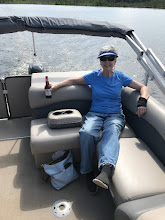By 10 a.m. the parking lot is already more than half full as we pull onto Navy Pier in downtown San Diego for our tour of the U.S. Midway, a 1945 era aircraft carrier which in her day was the world’s largest—the first too large to transit the Panama Canal in fact; and now a museum. The gangplank to board hums with the languages of many foreigners and groups of school children but because we did online tickets we get to bypass the ticket booth. Later in the day when we emerge, the line for tickets will snake back and forth and overlook an entirely full parking lot. Advice: come as early as you can.
The entrance puts you on the bow end of the hangar deck where it’s possible to grab earphones and radios for an audio tour of around forty stops but we bypass this in favor of wandering on our own which we do for the next three hours. Although many areas of the ship are open to tourists, there are vast areas which are not, but everything is well done. The only area we did not get to see was the bridge, due to a long wait since they only allow 20 at a time there, for about 20 minutes. Another thing to be aware of is that there are many shipboard type ladder stairways which are steep and narrow and head room throughout the lower decks is very limited as can be seen in these narrow hallways filled with piping and electrical wiring overhead.
The hangar deck, as to be expected, is quite cavernous with several interesting stops and filled with vintage planes and pieces of planes in which visitors can sit in cockpits or ejector seats. At the stern sits restrooms, a café and gift store. What used to be the elevator up for the planes is now filled with tables and chairs and offers a viewpoint of the San Diego skyline, the Coronado Bridge and an undercarriage view of the flight deck.
Stairs lead from this deck to the flight deck, again strewn with numerous aircraft including quite a few helicopters. I take particular interest in the Huey gunship—a symbol for my generation if there ever was one; a tragic reminder of the horrendous war in Vietnam which ended up taking the lives of quite a few of my graduating high school class. To this day I remember meeting a guy who was 26 years old and newly back from flying one of these gunships into battle day after day, who had just enrolled in Chico State using the GI bill for education. His hair was totally grey—not a speck of color left in it and when I asked he told me it had turned that way over the course of just a few short days flying mission after mission deep in the jungles. Up close and personal, even though this was the virtual workhorse of the entire war, it seems fairly small.
Access to the admiral’s and captain's quarters is off this deck and we step into relative luxury, with a small bedroom with en suite bath, a large lounge room with sectional furniture and an even larger gathering room which features a large table and chairs. Both sport private galleys also and had their own cooks.
Leading off the Captain’s quarters is the Situation Room which then further leads into the radar monitoring area. It is from here that the attack on Saddam Hussein in 1991 was launched so the area is salted with the real detritus of war—for instance, the original map of first day targets in Baghdad.
The crew and much of the real workings of the ship are down below on 2nd, 3rd, and 4th decks. Aircraft carriers really are cities at sea, housing and caring for 4500 personnel, including the vaunted 200 pilots. We toured mess halls and galleys (where 225 cooks toiled), laundries, barber shops and sick bays. Three dentists did so many x-rays; they had a lead lined room especially for that purpose, and a full dental lab. Operating rooms and pharmacy were staffed by five physicians.
One of our most intriguing stops was the radio and communications rooms; a virtual nightmare of knobs. Radio frequencies were adjusted to sort out which would go to the 1500 telephones aboard; talk about a switchboard!
Some fast facts of interest:
Original cost of $90,000,000 in 1945
1001 feet long, 258 feet wide
18 foot tall propellers
18 decks
2000 compartments
3.4 million gallon fuel capacity, 100,000 gallons used daily
Finally escaping the claustrophobic clutches of the ship, we made our way to Seaport Village where we enjoyed a unique three flavor pizza done up on a long board from Busters as we watched a magnificent view of the harbor and skyscrapers.
All in all, a great lesson in history and a very worthwhile tour if you are in the area.
skip to main |
skip to sidebar

And the road goes on forever...

Former fulltimers making a stationary life in WI.
And the road goes on forever...
Blog Archive
About Me

- Claudia
- Retired transplants to WI from a lifetime out West. Fulltiming gave way to building a house; now we also enjoy a destination trailer on our 15 acre Northwoods lakefront lot.



































